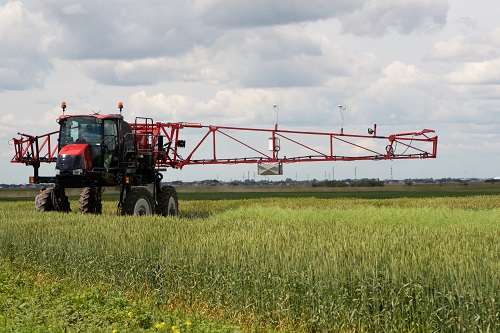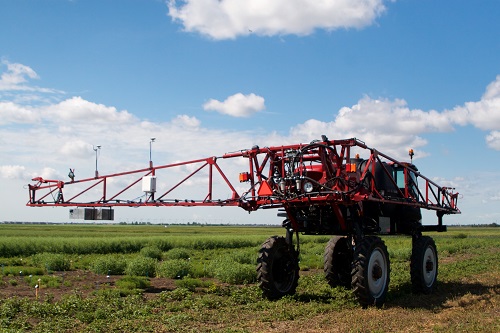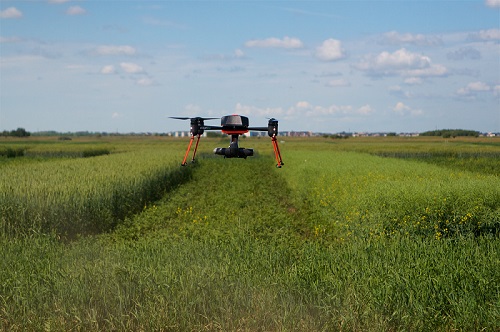Project Goal
To develop and utilize mobile platforms for data acquisition that will improve our understanding of, and efficiency in, plant breeding.
Project Summary
Supplying food for a growing population and increasing yield in a changing climate requires improvements in plant breeding. This research will develop methodologies to acquire and process high-resolution imagery for wheat, canola, and lentils. This imagery will be used to quantify crop phenometrics that will aid in plant breeding.
In 2016, Project 1.2 began a field experiment to phenotype diverse lines of wheat, canola and lentil crops over three seasons in several experiments. In order to develop digital phenotypes, the digital data and images collected will be processed using new algorithms. Eventually, these digital phenotypes will be associated with specific genes, which will help in understanding crop traits and used in genomic selection. This new image-based phenotyping method will be used to supplement the current method of manual field phenotyping to improve the efficiency of plant breeding.
These photos show a converted high-clearance sprayer used as a mobile platform to prototype and validate imaging technologies for use in plant phenotyping.


Project Results to Date
Scott Noble and his team of researchers are developing and using digital instruments on a mobile platform that moves through the field collecting imaging data. These instrument payloads provide a range of high-resolution data sources, including imagery in the ultra-violet, visible, near-infrared, and thermal spectral regions, laser-scanning, and ultrasonic sensors. The payloads use measurements of local environment and sky conditions to better interpret the data. These instruments provide very high resolution images, are easy to transport, and can stay outside for long periods of time.
More fundamental investigations are also underway to improve our understanding of how leaf characteristics (such as biochemistry, internal structure, and surface) influence light, how the plant looks from different perspectives, and how it looks under different lighting conditions. This work will help ensure that the Project 1.2 team is working with high quality data and has the models to interpret it properly.
Steve Shirtliffe and his team are using unmanned aerial vehicles (UAVs or “drones”) to collect imaging data from several plant breeding experiments. Current projects include the quantification of flowering in canola genotypes, 3-D modelling of lentil canopy development, utilizing aerial and ground imagery to quantify emergence and spike development in wheat, quantification of stay-green potential in wheat and heat tolerance in pulses.

Practical Applications
- This combination of platform and aerial imaging allows researchers to collect high quality, quantitative data in the field under real environmental and growing conditions. These tools enable plant breeders to select better plant varieties within a shorter time period and have a better, narrower focus on the traits they are looking for. This will lead to an improved understanding of crop development and enable plant breeders to select better genotypes.
- The high resolution images obtained will aid in developing important models for interpretation. These models will allow researchers to collect important metrics that were previously impossible to measure (destructive measures) or too time consuming to measure. In addition, regular imaging is conducted in order to track changes in crop phenotypes over time, instead of the one-time measures usually associated with manual crop phenotyping.
- Information obtained through the images makes researchers better equipped to monitor plant responses to different stimuli over a longer time frame, and ultimately learn about the strategies needed to maintain and improve crop yield.
- A further application of this project is precision agriculture, a concept based on observing, measuring, and responding to variability in crops which results in better crop management. Imaging of many ground truthed plant breeds and agronomics will facilitate the development of evidence-based precision agriculture.
Collaborations
Project 1.2 is highly integrated with several other P2IRC Projects, including most notably:
- Project 3.2: Data Analysis for Rapid Plant Phenotyping is a computer science project focused on developing the software needed to automatically and quickly analyze plant and crop images. Project 1.2 is working with 3.2 to develop the image analysis pipeline that will allow processing and data extraction from the Tera-bytes of imagery and sensor data. They are also working with 3.2 to utilize computer image analysis methods to quantify differences in field phenotypes of crop genotypes.
Research Team
Project Leads:
Loading...
Research Associates:
Tyrone Keep
David Pastl
Hema Duddu
Seungbum Ryu
Menglu Wang
Keshav Singh
PhD Students:
Reisha Peters
MSc Students:
Keith Halcro
Ti Zhang
Karsten Neilsen
Anique Josuttes
Keegan Strueby
Undergraduate Students:
Simone Harry
Devin Hinz
Kaitlin McNabb


